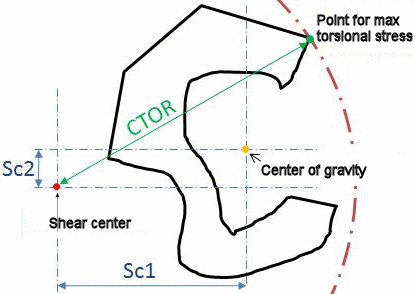Defines a beam or truss, joint conditions, and section properties of the selected beams. For beams, you control the transfer of forces and moments to each end. This allows you to release (set to zero) any of the force and moment components at the end. Note that restraints apply to joints and hence to all beam ends that meet at the joint.
The options specified here override restraints. For example, if you define a beam end as a Hinge and apply a Fixed restraint to the associated joint, the specified beam end acts as a Hinge and does not carry any moment.
In the Simulation study tree, right-click a beam definition and click Edit Definition.
Type
Sets the type of the element for the selected structural members.
| Beam |
A beam element resists axial, bending, and torsional loads.
|
| Truss |
A truss element can resist axial loads only just like an axial spring.
|
| Show beam direction |
Toggles the visibility of the beam directions in the graphics area. The red arrow shows the positive axial direction, the green arrow shows the positive direction 1, and the blue arrow shows the positive direction 2 for the selected beams.

|
Beam forces and streses are listed with respect to the beam's local coordinate system. Beams or trusses under axial compressive loads show a negative axial beam stress value and beams under axial tensile loads show a positive axial beam stress value.
End1 Connection
Sets the forces and moments at End 1  of the beam. Used for beams only.
of the beam. Used for beams only.
End 1

and End 2

of the beam are highlighted in the graphics area in different colors.
| Rigid |
No forces or moments are released at this end. If restraints are applied to the associated joint, the restraint condition fully defines the transfer of forces and moments. If no restraints are applied, continuity is assumed at the associated joint. Use this option unless there is a reason to release (set to zero) force or moment components at this end.
|
| Hinge |
The end can rotate freely and does not transfer any moments to the joint. Apply this condition to all beam ends meeting at a joint to define the joint as an intermediate hinge.
|
| Slide |
The end can translate freely and does not transfer any forces to the joint.
|
| Manual |
For each force and moment component, specify whether it is known to be zero manually.
|
Hinge- 1st direction
|
Select this option to set the moment about the first direction of the cross section to zero. The end can rotate about this direction.
|
|
Hinge- 2nd direction
|
Select this option if the moment about the second direction of the cross section is known to be zero. The end can rotate about this direction.
|
|
Hinge- Along beam
|
Select this option if the moment about the axial direction of the beam is known to be zero. The end can rotate about this direction.
|
|
Slide - 1st direction
|
Select this option if the force in the first direction of the cross section is known to be zero. The end can translate along this direction.
|
|
Slide - 2nd direction
|
Select this option if the force in the second direction of the cross section is known to be zero. The end can translate along this direction.
|
|
Slide - Along beam
|
Select this option if the force in the axial direction of the beam is known to be zero. The end can translate along this direction.
|
|
End2 Connection
Sets the forces and moments at End 2  of the beam. Options are similar to End 1
of the beam. Options are similar to End 1  .
.
Section Properties
For structural members that use weldment profiles from the SOLIDWORKS database, the software calculates the section properties. For custom beam profiles, enter the user-defined section properties.
| Units |
Unit of length for the calculation of torsional constant and distance for maximum torsional shear.
|
| Torsional Constant (K) |
Displays the torsional stiffness constant (length to the fourth power). The torsional constant is a function of the beam's cross-section.
The software calculates the torsional constants for most of the beam profiles. For formulas of torsional constants for various cross-sections, see reference Formulas for Stress and Strain, Roark and Young, Chapter 9, Table 20.
|
| Distance for Max Shear (CTOR) |
Maximum distance from the shear center of the section to the furthest point on the cross section (radius ot the circumscribed circle centered at the shear center).
 The maximum torsional shear stress is then calculated from: τ max = ( T / K )* CTOR , where T is the applied torque.
|
| Shear Factor |
The shear factor accounts for the nonuniform shear stress distribution across the beam's cross-section. Its value depends on the shape of the beam's cross-sectional area. For example, for a rectangular section the shear factor is 5/6; for a solid circular section is 9/10; for a hollow circular section is 1/2.
The shear factor is considered in the calculation of the total strain energy of the beam due to shear. See reference Simplified Method for Calculating Shear deflections of beams by Ivan Orosz, USDA Forest Service Research Note FPL-0210 for the derivation of the shear factor.
|
| Reset |
Resets the variables to their default values.
|